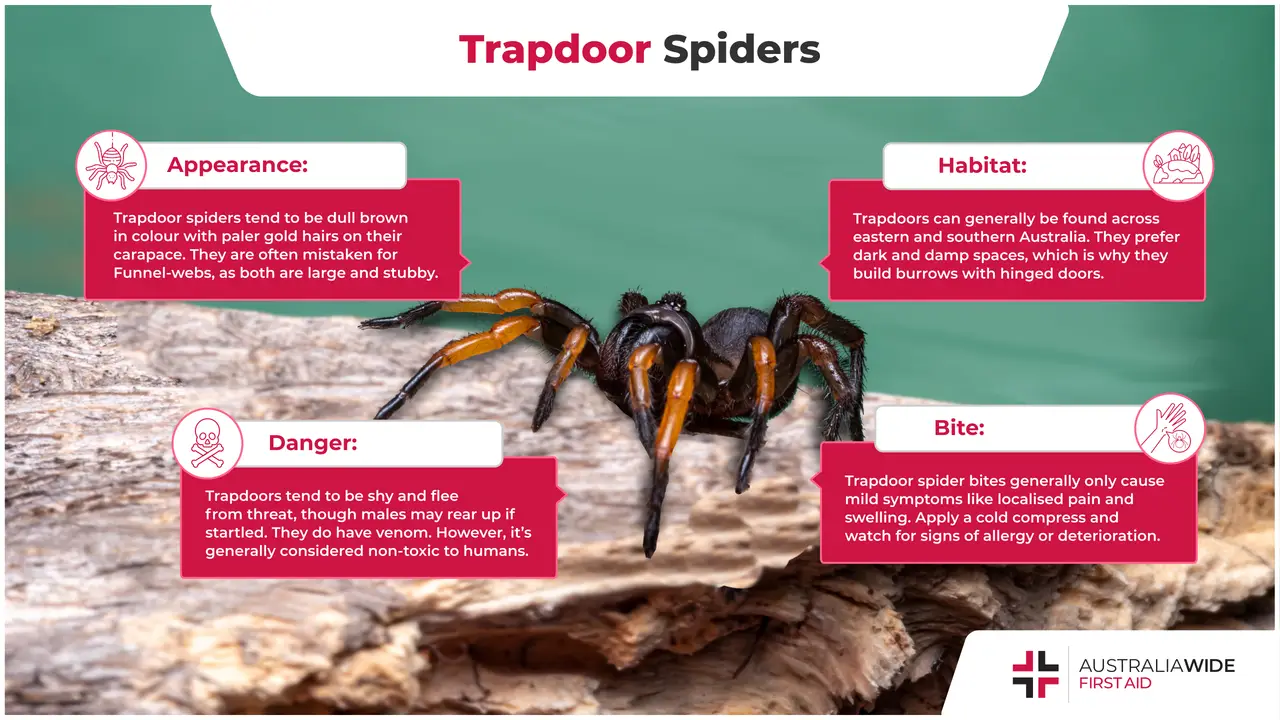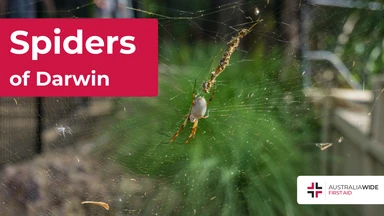Trapdoor Spiders: The Tunnel-building Arachnid


Despite being known for their unique trapdoors based at the entrance of their burrows, not all trapdoor spiders make a door for their burrows.
Rather, the trapdoor spider is a common name for any several large, hairy, and generally harmless tropical spiders that nest underground.
The common name covers several families of spiders including the Idiopidae, Actinopodidae, Ctenizidae, Migidae and Cyrtaucheniidae. The most common trapdoor spiders such as the Brown Trapdoor and Spotted Trapdoor belong to the family Idiopidae. The brown trapdoor spider, and the most popularly known spider, is primarily found around Sydney, Australia. This spider is often mistaken for the far more dangerous Funnel-Web Spider due to similar identifying features such as being both large, dark, and rather stubby with a hairy coat.
These spiders are common in gardens, and are found across Eastern and Southern Australia, including Tasmania. They often prefer dark and damp spaces, and their burrows can be found while moving rocks or digging soil. Trapdoor spiders normally spend their entire life inside the burrow with females being able to live up to 20 years long while males have a much shorter life. After 2 or 3 years, trapdoor spiders often leave their burrows in late autumn to early winter to roam the outside world in search of a potential mate.
While there are many different species of trapdoor spiders, some don’t make a hinged door at the entrances at their burrows. However, one thing they all have in common: they dig a burrow that acts as both a home and a ‘trap’ – awaiting their next victim patiently in the safety of the ground.
While you are unlikely to see a trapdoor spider due to their shy nature, you may notice some similar identifying features with the funnel-web spider. They usually flee from any threat, however, it’s good to exercise extreme caution and recognise the difference between the trapdoor and their dangerous cousins.
Here are some identifiers that are typical of the trapdoor spider:
Trapdoor spiders feed by waiting for unsuspecting victims to wander past their burrows with the door open just a crack. Once the prey is in sight, these spiders leap out at great speeds to seize its prey before hauling it back into the burrow to be devoured – all in the blink of an eye. On the other hand, these trapdoors also make a great hiding spot from dangerous predators such as birds, bandicoots, centipedes, scorpions, parasitic wasps, and flies.
When the trapdoor is closed, the spider’s home is very well hidden. Trapdoor spiders often spend their time using silk, dirt and bits of moss or plants to camouflage their ingenious trapdoors. There are little holes in the bottom of the trapdoor that enables these spiders to hold onto the door using their legs – these can be used to push the door open or to hold the door closed in case a predator may try entering their burrow.
These spiders also play an important role in controlling the number of cockroaches, beetles, crickets, and even other spiders. Generally, they are not considered to be a major threat to humans. If you see a small burrow in the ground lined with silk roughly 250mm in depth and 25mm in width, it’s best to leave them alone to tend to the local garden pests.

While trapdoors tend to be shy and flee from any threat, males may rear up if startled unexpectedly. A bite from a Brown Trapdoor Spider may cause some local pain and swelling to the area but generally will not cause any complications. Sigillate Trapdoor Spiders on the other hand may also cause local pain and swelling. However, it’s recommended to exercise caution and apply a cold pack to relieve the pain if needed.
If these symptoms persist, seek medical attention as soon as you can. Because of their similarities with funnel-web spiders, it’s recommended to collect the spider for a positive identification in the event of a bite. Whether they’re threatening or non-threatening, it’s always a good idea to give spiders a bit of space whenever you can. Better to be on the safer side of things!
Continue reading for a full outline of the correct first aid procedure for a Trapdoor Spider bite.
Trapdoor spider bites should be treated in the same manner as a Funnel-web spider bite, as there are approximately 40+ varieties of large black spiders, so it is worthwhile to treat for the worst and hope for the best:
If you are worried about your symptoms, or if they persist or worsen over several days, seek medical attention.
If the casualty begins exhibiting signs of a severe allergic reaction, otherwise known as anaphylaxis, call Triple Zero (000) for an ambulance, consult the Australian Resuscitation Council's anaphylaxis treatment guideline, and follow DRSABCD and be prepared to perform CPR.
Trapdoor spiders are mainly harmless and mind their own business throughout the gardens and bushlands in Australia. However, it’s never a good idea to go looking for them as you may receive a nasty bite when encountered. These wild animals can be unpredictable, and it’s recommended for you to learn first aid in the event of a serious bite.
Make sure to attend one of our First Aid Courses to learn more about treating various spider bites and what to do in case of an emergency.
We also have articles on what to do if you get stung or bitten by a snake, fire ant, and different types of marine life.
And for more details on how to identify and treat bites from some of Australia's deadliest spiders, including White tail spiders, Wolf spiders, Huntsman spiders, and Redback spiders, head to our Resource Library.
Disclaimer: This article is for informational purposes only. It does not constitute, replace, or qualify as any form of first aid training.

March 11, 2025
Darwin, the tropical capital of Australia’s Northern Territory, is home to a rich diversity of wildlife - including an impressive array of spiders. From the sprawling webs of golden orb-weavers to the cryptic camouflage of trapdoor spiders, these arachnids play a vital role in the local ecosystem. While some may inspire fear, the majority are harmless and even beneficial, helping to control insect populations.

September 4, 2024
Cat bites, while often underestimated, can lead to serious health complications if not treated promptly and properly. Cats' mouths harbour a variety of bacteria that can cause infections in humans.

April 1, 2024
Encounters with wildlife can often be thrilling, but when it comes to the creature known as the drop bear, the experience can quickly turn dangerous. A sharp increase in recent attacks prompts the need for understanding proper first aid procedures in case of an attack.